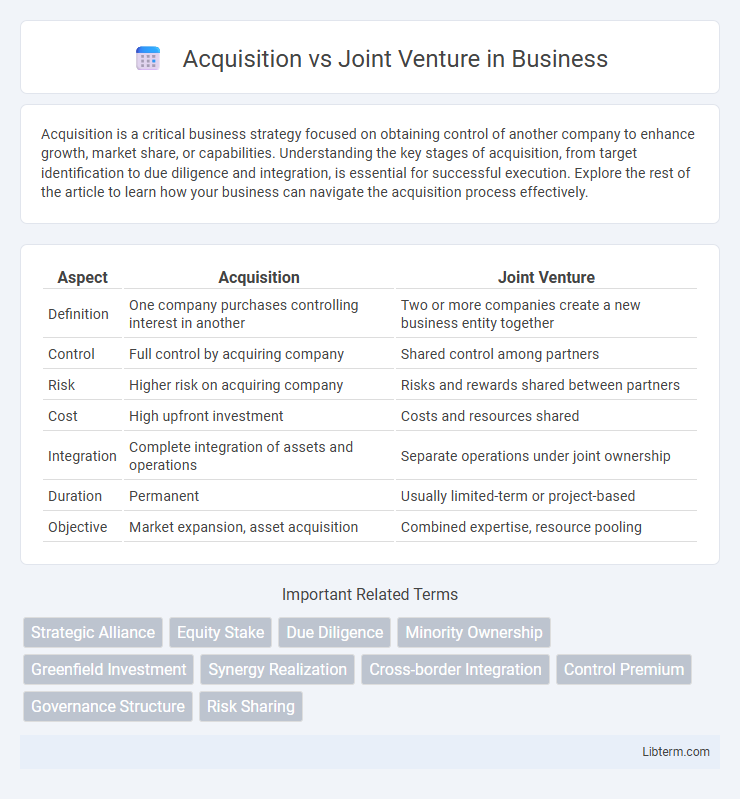Acquisition is a critical business strategy focused on obtaining control of another company to enhance growth, market share, or capabilities. Understanding the key stages of acquisition, from target identification to due diligence and integration, is essential for successful execution. Explore the rest of the article to learn how your business can navigate the acquisition process effectively.
Table of Comparison
| Aspect | Acquisition | Joint Venture |
|---|---|---|
| Definition | One company purchases controlling interest in another | Two or more companies create a new business entity together |
| Control | Full control by acquiring company | Shared control among partners |
| Risk | Higher risk on acquiring company | Risks and rewards shared between partners |
| Cost | High upfront investment | Costs and resources shared |
| Integration | Complete integration of assets and operations | Separate operations under joint ownership |
| Duration | Permanent | Usually limited-term or project-based |
| Objective | Market expansion, asset acquisition | Combined expertise, resource pooling |
Introduction to Acquisition vs Joint Venture
Acquisition involves one company purchasing another to gain full control and integrate operations, enhancing market share and resources. A joint venture, however, is a strategic alliance where two or more firms create a separate entity to collaborate on specific projects while sharing risks and profits. Both approaches serve growth objectives but differ fundamentally in ownership structure, control, and operational integration.
Definition of Acquisition
Acquisition refers to the process where one company purchases most or all of another company's shares to gain control of that company, creating a single consolidated entity. This strategic move allows the acquiring company to expand its market reach, enhance capabilities, and increase competitive advantage quickly. Unlike joint ventures, acquisitions result in full ownership and operational control rather than a shared partnership.
Definition of Joint Venture
A joint venture is a strategic business arrangement where two or more parties agree to pool resources, share risks, and collaborate on a specific project or business activity without merging their entire operations. Unlike acquisitions, where one company takes full control over another, joint ventures allow partners to maintain their separate legal identities while jointly managing the venture. This partnership structure enables companies to leverage complementary strengths, access new markets, and share technology or expertise on a defined business initiative.
Key Differences Between Acquisition and Joint Venture
Acquisition involves one company purchasing another, resulting in full ownership and control, whereas a joint venture is a strategic alliance where two or more parties share ownership and governance of a new entity. Acquisitions lead to complete integration and consolidation of assets, while joint ventures preserve the independence of the involved companies with shared risks and profits. Financial implications in acquisitions include upfront capital expenditure and potential restructuring costs, contrasting with joint ventures where investment and returns are proportionately divided among partners.
Advantages of Acquisition
Acquisitions provide companies with full control over the acquired business, enabling faster decision-making and integration processes. They offer access to established customer bases, proprietary technologies, and intellectual property without the complexities of shared governance. Financially, acquisitions can create immediate revenue growth and economies of scale, enhancing competitive positioning in the market.
Advantages of Joint Venture
Joint ventures enable businesses to share resources, risks, and expertise, fostering innovation and market expansion that might be unattainable individually. They provide access to new markets and distribution channels while allowing companies to maintain their separate identities and operational control. This collaboration facilitates cost-sharing and enhances competitive advantage through combined strengths and local knowledge.
Risks and Challenges in Acquisition
Acquisition risks include cultural integration issues, potential loss of key talent, and unforeseen financial liabilities that can impact overall profitability. Challenges also arise from regulatory approvals, misaligned strategic objectives, and difficulties in merging systems and processes. These factors can lead to operational disruptions, reduced employee morale, and strained stakeholder relationships post-acquisition.
Risks and Challenges in Joint Venture
Joint ventures pose significant risks such as shared liability and conflicting management styles, which can hinder decision-making and operational efficiency. Differing corporate cultures and strategic goals between partners increase the challenge of aligning objectives and maintaining trust. Legal complexities and potential regulatory hurdles further complicate joint ventures compared to acquisitions, demanding thorough due diligence and clear contractual agreements.
Factors to Consider When Choosing Between Acquisition and Joint Venture
When choosing between acquisition and joint venture, critical factors include control over operations, financial resources, risk tolerance, and strategic objectives. Acquisitions offer full control and integration but require significant capital and carry higher risks, while joint ventures enable shared resources and risks with partners, fostering collaboration but limiting control. Market entry speed, cultural compatibility, and long-term goals also influence the decision to pursue acquisition or joint venture arrangements.
Conclusion: Which Strategy is Best?
Acquisition offers full control and faster integration, making it ideal for companies seeking rapid market expansion and complete ownership. Joint ventures provide shared risks, local expertise, and resource pooling, benefiting businesses aiming for collaboration and market entry with limited investment. The best strategy depends on a company's financial capacity, risk tolerance, and long-term objectives in the target market.
Acquisition Infographic

 libterm.com
libterm.com